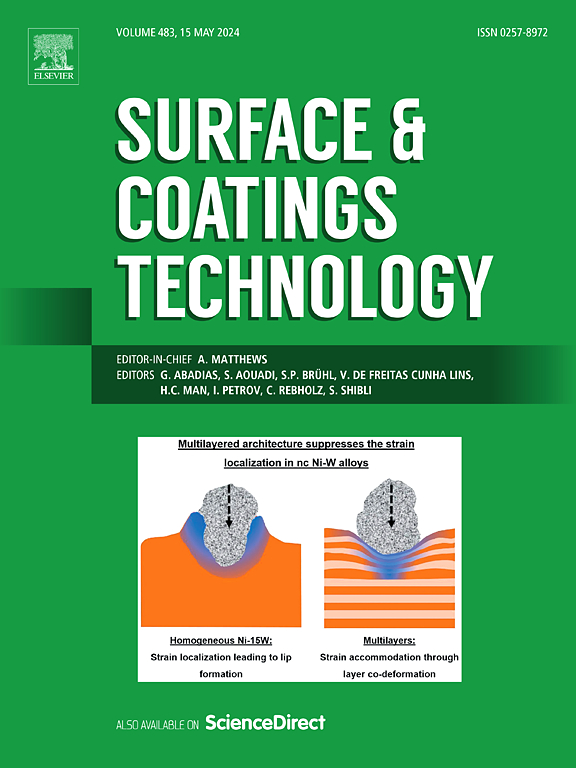Ellipsometric characterization of magnetron sputtered metal-dielectric-metal (MDM) multilayers for Optical Vernier Scale biosensors with ultra-high sensitivity and large dynamic range
IF 5.3
2区 材料科学
Q1 MATERIALS SCIENCE, COATINGS & FILMS
引用次数: 0
Abstract
We provide a systematic investigation of the optical properties of a hybrid plasmonic–photonic Optical Vernier Scale (OVS) biosensor using multiple zero-reflection points (ZRPs) with ultra-low limit of detection (LoD) of ~10−8 refractive index unit (RIU) and large dynamic range of ~6 orders of magnitude in RIU sensing. The synergic collaboration of p- and s-polarized ZRPs results in the OVS operation mode that enables precise optical quantification of biomolecular interaction events based on the dynamic fitting of the sensing medium's refractive index changes. The optical model provides a quantitative description of the biosensor operation in terms of its structure and the parameterized dispersion properties of the constitutive silver (Ag) and aluminum nitride (AlN) layers, in the spectral range from 320 to 1690 nm, as well as the ability to follow the dynamic RIU changes in real-time during sensor functionalization and operation. The AlN thin films were first deposited on glass substrates by reactive magnetron sputtering from Al target under different Ar/N2 gas ratios at room temperature. The optical constants, thickness, and surface roughness of the AlN thin films were then investigated using spectroscopic ellipsometry. It was found that the reactive gas flow ratio can control the optical properties of the AlN films. When the reactive gas ratio was adjusted from 30 % to 70 %, the refractive index (n) of the AlN thin films varied from 1.75 to 1.84 at a wavelength of 633 nm, the extinction coefficient (k) of the AlN samples varied from 0.005 to 0.05 at a wavelength of 233 nm, and the band gap , defined where the extinction coefficient k < 0.001, varies between 0 and 5.03 eV. Finally, the application of the AlN film in a metal-dielectric-metal (MDM) multilayer was investigated, showing unique spectral characteristics by total internal reflection ellipsometry measurements and used for the bio-detection of rabbit IgG with a LoD below 10 ng/mL. The demonstrated stability and reliability of our fitting method, coupled with the excellent sensitivity of the MDM multilayer structure, make this system highly competitive in the field of biosensing.
求助全文
约1分钟内获得全文
求助全文
来源期刊

Surface & Coatings Technology
工程技术-材料科学:膜
CiteScore
10.00
自引率
11.10%
发文量
921
审稿时长
19 days
期刊介绍:
Surface and Coatings Technology is an international archival journal publishing scientific papers on significant developments in surface and interface engineering to modify and improve the surface properties of materials for protection in demanding contact conditions or aggressive environments, or for enhanced functional performance. Contributions range from original scientific articles concerned with fundamental and applied aspects of research or direct applications of metallic, inorganic, organic and composite coatings, to invited reviews of current technology in specific areas. Papers submitted to this journal are expected to be in line with the following aspects in processes, and properties/performance:
A. Processes: Physical and chemical vapour deposition techniques, thermal and plasma spraying, surface modification by directed energy techniques such as ion, electron and laser beams, thermo-chemical treatment, wet chemical and electrochemical processes such as plating, sol-gel coating, anodization, plasma electrolytic oxidation, etc., but excluding painting.
B. Properties/performance: friction performance, wear resistance (e.g., abrasion, erosion, fretting, etc), corrosion and oxidation resistance, thermal protection, diffusion resistance, hydrophilicity/hydrophobicity, and properties relevant to smart materials behaviour and enhanced multifunctional performance for environmental, energy and medical applications, but excluding device aspects.
 求助内容:
求助内容: 应助结果提醒方式:
应助结果提醒方式:


